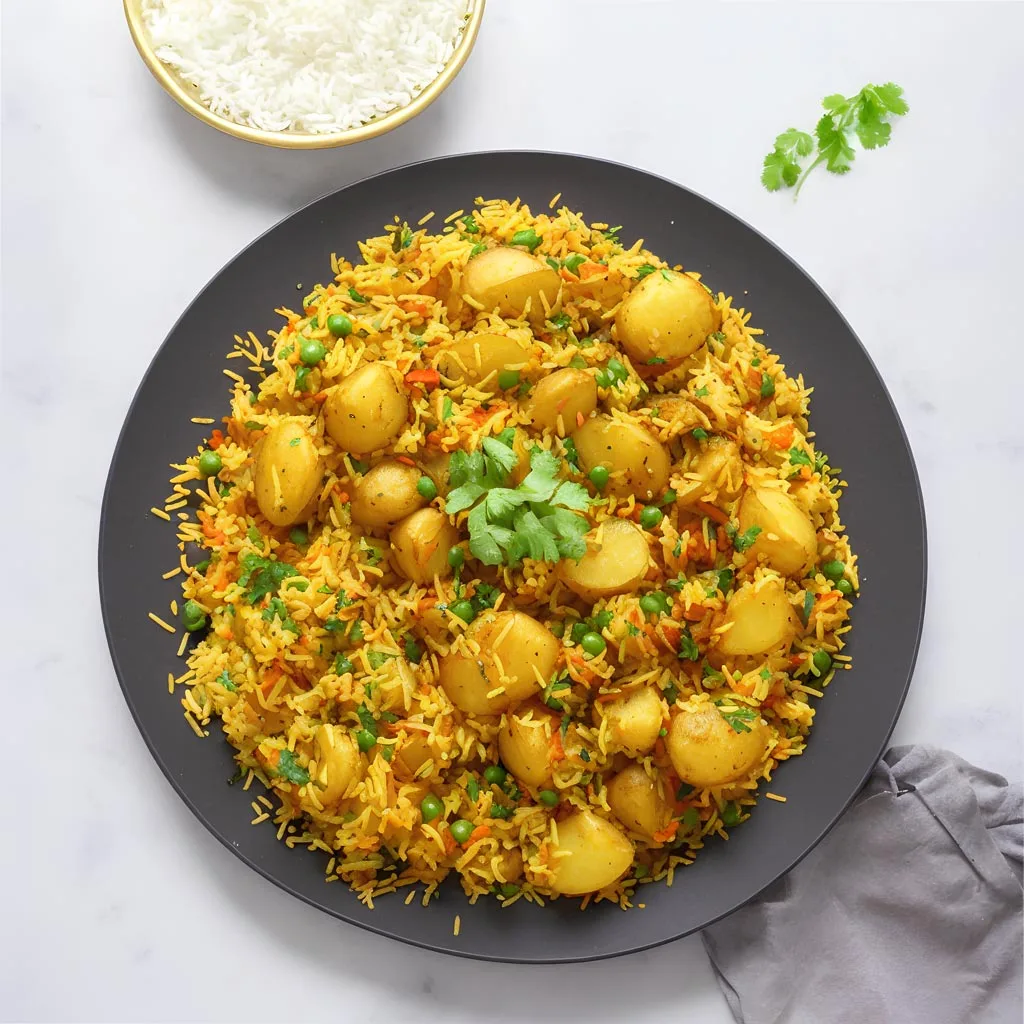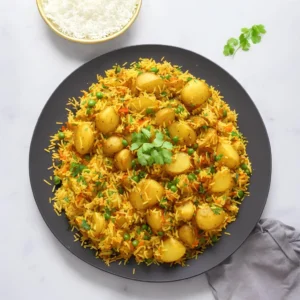
Welcome to the aromatic world of Vegetable Biryani! Originating from the Indian subcontinent, this delightful dish has captured hearts and taste buds worldwide with its tantalizing flavors and vibrant colors.
Veg Biryani, a vegetarian twist on the classic biryani, offers a mouthwatering blend of fragrant basmati rice, assorted vegetables, and a medley of aromatic spices.
Crafting a perfect Veg Biryani is an art that combines the simplicity of everyday ingredients with the complexity of spice blending. Despite its rich flavors and sophisticated appearance, this dish is surprisingly easy to prepare, making it an ideal choice for both beginners and seasoned cooks alike.
Whether you’re hosting a dinner party or simply craving a wholesome meal, Veg Biryani is sure to impress with its exquisite taste and aromatic aroma.
Expert Tip: Rinse the basmati rice thoroughly under cold water until the water runs clear to remove excess starch and prevent the rice from becoming sticky.
Basmati Rice: This long-grain rice is known for its fragrant aroma and light, fluffy texture when cooked. It is the backbone of any biryani, imparting a delicate flavour and perfectly absorbing the spices and flavours of the dish.
Potatoes and Carrots: These root vegetables provide substance and a variety of textures to the biryani. Their mild flavours soak up the vibrant spices while adding a hint of earthiness and natural sweetness respectively. In a pinch, parsnips or sweet potatoes could work as replacements.
Onion: Sautéed until golden brown, onions add a sweet and savoury depth to the dish. The caramelization process unlocks their inherent sweetness, giving the biryani a rich flavour base.
Green Peas: They add a pop of colour and a burst of sweetness with each bite. Their firm texture balances the softness of other vegetables. Frozen peas can be used in place of fresh ones.
Whole Spices: This group of spices, referred to as “whole spices,” imparts an unmistakable aroma and warmth to the biryani. Each spice has its unique profile – cumin’s earthiness, cardamom’s sweet-spicy notes, cloves’ pungent warmth, cinnamon’s sweet spiciness, and bay leaf’s subtle bitterness.
Vegetable Oil: Used as a cooking medium, it’s the vehicle that allows the spices to release their essential oils and flavours. You can substitute it with any neutral oil or even ghee for a richer flavour.
Ginger and Garlic Paste: These add a pungent depth to the dish and help in balancing the flavours. They also have digestive benefits. If pastes are unavailable, fresh ginger and garlic, finely minced, would serve just as well.
Spices: These ground spices add a world of flavour, giving the biryani its characteristic warmth, spiciness, and vibrant colour. While each spice is unique, curry powder could be used as a substitute if necessary.
Salt: An essential seasoning that amplifies all other flavours and brings balance to the dish. While the amount is subjective to individual taste, it’s a crucial component that shouldn’t be omitted.
Coriander: Garnishing with fresh coriander leaves adds a refreshing note, contrasting the warm, spiced biryani. Its vibrant green also makes for a visually appealing dish. Parsley could be used as a substitute, though it won’t offer the same flavour profile.
Expert Tip: For enhanced flavor, toast the whole spices (cumin seeds, cardamom pods, cloves, cinnamon stick, and bay leaf) in the hot oil before adding the onions.
Expert Tip: For a richer and more indulgent biryani, you can add a layer of fried onions and/or boiled eggs between the layers of rice and vegetables before cooking.
Yes, feel free to customize Veg Biryani with your favorite vegetables such as bell peppers, cauliflower, or green beans to suit your taste preferences.
While basmati rice is traditionally used for biryani due to its distinct aroma and texture, you can substitute it with brown rice for a healthier alternative. Keep in mind that the cooking time and liquid ratio may vary.
To ensure fluffy and separate grains of rice, parboil the rice before layering it with the cooked vegetables. Be careful not to overcook the rice during the parboiling stage, as it will continue to cook further when layered with the vegetables.
Yes, you can prepare Veg Biryani in advance and reheat it before serving. Store the cooked biryani in an airtight container in the refrigerator for up to 2-3 days. Reheat gently in the microwave or on the stovetop, adding a splash of water if needed to prevent drying out.
Absolutely! Adding toasted nuts such as almonds, cashews, or raisins can add a delightful crunch and sweetness to Veg Biryani. Simply stir them into the rice before serving for an extra layer of flavor and texture.
Here are some more recipes for you to enjoy! If you my recipes don’t forget to rate and leave a comment.
If you have any recipe suggestions, please do not hesitate to ask me. A great way to stay in contact with me is through Instagram, Facebook, Twitter and YouTube. Don’t forget to tag me @CookwithNabeela in your recipe photos!

Subscribe now to receive my latest recipes directly in your inbox. Stay up-to-date and never miss out!

I love to cook! I want to share with you my favourite, delicious family-friendly recipes. I want to inspire you to create fantastic food for your family every day.
Latest comments (4)
I made it, it was very tasty.
I’m thrilled to hear that you enjoyed the biryani! If you have any more questions or if there’s anything else you’d like to try, feel free to reach out.:)
Can I use sweet potato instead of potato in this?
Absolutely, you can substitute sweet potato for regular potato. It will add a unique sweetness and a slightly different texture to the dish. Enjoy experimenting with the flavours!